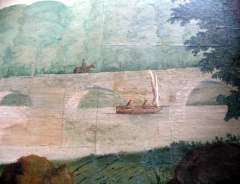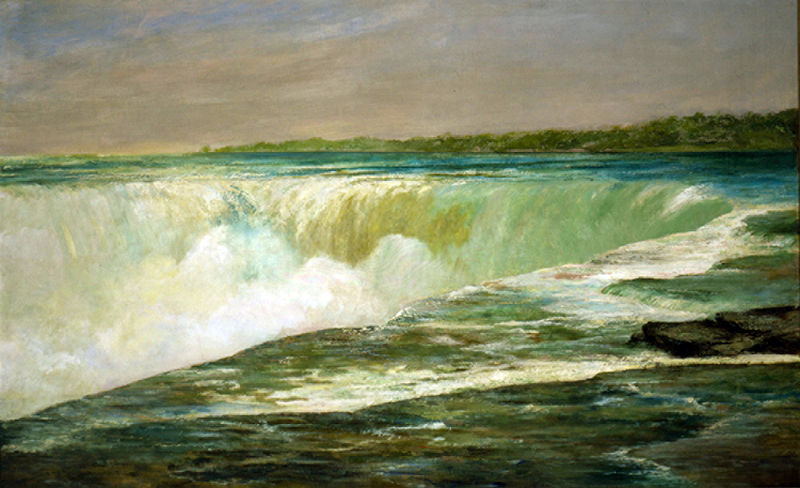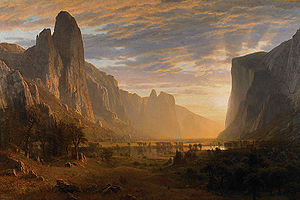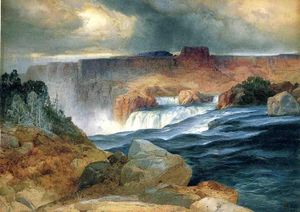American Landscapes Painting
 From Conservapedia
From Conservapedia American landscapes painting has an interesting history of works and painters. Its evolution spans over three centuries. Works of John Constable and Richard Parkes Bonington influenced American landscape painting.
Earliest American painters used landscapes only as background of portraits. In the early 19th century landscape painting became the vehicle for depicting the American identity. As American artists returned from Europe, their depictions of the national landscape changed from sublime vistas to those of a more intimate and individual approach.[1] The first painting school of American art was the Hudson River of landscape painters. The Hudson River School style involved carefully detailed paintings with romantic, almost glowing lighting; It was not an institution but rather an informal group of like-minded painters. Thomas Cole (1801-1848) is acknowledged as the founder of this movement. The movement was fueled by the poetry of Ralph Waldo Emerson (1803-1882) and by the conviction that God had given the American people an abundance of natural resources as a source of wealth and prosperity. [2]
Abstract American painters of the twentieth century approached landscape with a variety of styles, fostering a uniquely American expressionism.
Famous American landscape painters are: Asher Brown Durand, George Catlin, Thomas Cole, John Mix Stanley, William Bradford, Frederic Edwin Church, Albert Bierstadt, Winslow Homer, George Caleb Bingham, John James Audubon, Thomas Moran, William Merritt Chase, John Henry Twachtman, John Singer Sargent, Seth Eastman and Ian Hornak.

Asher Durand, Dover Plains, Dutchess County, New York, 1848.

The Voyage Of Life, Manhood by Thomas Cole, 1842.

Frederic Edwin Church, Cotopaxi, 1855.

An Arizona Sunset Near the Grand Canyon, by Thomas Moran, 1898.

The Gulf Stream by Winslow Homer, 1899.

Tiepolo's Window by Ian Hornak, 1974.

Michel Felice Corne, Mural in stairway.
Cole's followers, the painters of the Hudson River School (like Frederic Edwin Church), who began to paint in the years following American Independence, were the artists who definitively established American painting as a separate school, and who broke away from the influence of English art which had until then predominated. Ibidem
| “ | By the 1830s, landscape painting had become the vehicle for depicting a national identity. Throughout the rest of the century, the depiction of the American land took a variety of forms - as mysterious and sublime wilderness, a new territory requiring scientific documentation, the pioneers' territorial and natural destiny, or as the individual's private retreat.[3] | ” |

Niagara Falls by William Morris Hunt.
See also[edit]

- American Painting
- Famous landscape paintings
- Landscapes from around the world
- American Impressionism Gallery
- American Seascapes
- American History Painters
- Famous Still Life Paintings



External links[edit]

- American Landscape Painting.
- Landscape Painting.
- American landscape artists.



References[edit]

- ↑ 19th Century American Landscape Painting.
- ↑ The Hudson River School.
- ↑ Masterpieces of American Art

Categories: [American Painting] [American Painters] [Painting]
↧ Download as ZWI file | Last modified: 02/16/2023 07:22:28 | 43 views
☰ Source: https://www.conservapedia.com/American_landscapes_painting | License: CC BY-SA 3.0
 ZWI signed:
ZWI signed: KSF
KSF